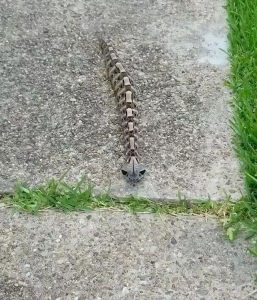That all of us are destined to grow old and grey is one of life’s few certainties. I’ve always had a slight fear of snakes, which is probably why they fascinate me so much. Fortunately, I live in a part of the world where venomous snakes are rare, so the chances of running into a dangerous one are low. Still, the combination of fear and curiosity often draws me into the world of these incredible creatures. And among the most intriguing of all is a reptile that seems more myth than reality: the Gaboon Viper.

Hidden deep in the lush rainforests of Africa, the Gaboon Viper is a breathtaking marvel of nature. With its almost artistic camouflage, potent venom, and unmatched hunting skills, this snake has earned a reputation as one of Africa’s most formidable predators. Today, we’ll journey into its mysterious world, uncovering what makes this animal so extraordinary and why it commands both respect and awe.
Also known as the Gaboon adder, this snake ranks among the largest and most dangerous vipers on the African continent. Native to the dense rainforests and dry savannas of Central and West Africa, the Gaboon Viper has developed an intricate and beautiful skin pattern that helps it disappear into its environment. It is a master of camouflage, blending so perfectly into the forest floor’s leaf litter that even a trained eye might miss it.
When it comes to size, the Gaboon Viper is a giant. Second only to exceptionally large King Cobras, these snakes can grow beyond six feet in length and weigh over 20 pounds. But what really sets this species apart—and sends chills down the spine—is its massive fangs. Measuring up to two inches long, they hold the record for the longest fangs of any venomous snake. These fangs aren’t just for show; they deliver one of the most potent venom doses in the snake kingdom.
The venom is a complex mix of enzymes and toxins designed to quickly immobilize and break down tissue. It causes intense pain, severe swelling, and massive tissue damage—and without prompt medical treatment, it can be fatal. That said, the Gaboon Viper is not known for aggression. It rarely bites humans unless provoked or stepped on, which, given its expert camouflage, is unfortunately possible.
The Gaboon Viper has a large, triangular head and hypnotic skin markings that almost resemble a work of art. But beneath the beauty lies a cunning predator. This snake is the ultimate ambush hunter. It lies completely still for hours, sometimes even days, waiting for the perfect moment to strike. It preys on fully grown rabbits, monkeys, and even small antelopes, showing off its ability to take down surprisingly large meals.
Despite its lethal capabilities, human encounters with the Gaboon Viper are rare. Its preference for remote areas and its generally passive nature means that most people will never come across one in the wild. However, when encounters do happen, they can be dangerous—especially when a person unknowingly steps on one hidden in the brush.
What makes this snake even more dangerous is its ability to hold on to its prey after biting, injecting a massive dose of venom in the process. This makes treatment especially urgent. In such cases, the availability of anti-venom can mean the difference between life and death.
While the Gaboon Viper is naturally found only in Africa, that hasn’t stopped some people in the United States from keeping them as exotic pets. Their massive size and striking appearance make them attractive to certain reptile enthusiasts, but this fascination can come at a steep price. One such case unfolded in Virginia in 2022, when a man keeping a Gaboon Viper as a pet was bitten. Emergency responders rushed him to Richmond Hospital in critical condition.
Complicating the situation was the lack of anti-venom at the VCU Medical Center. Their supply, previously provided by the Smithsonian National Zoo, had run out. Thankfully, in a remarkable show of collaboration, the Virginia Aquarium and Marine Science Center stepped in and delivered 35 additional vials of anti-venom to help save the man’s life.
Strangely, this wasn’t the only such incident that year. A few months earlier, a man in North Carolina was also bitten by a Gaboon Viper. He needed a staggering 44 vials of anti-venom to survive and tragically lost several fingers due to the bite. These events serve as sobering reminders of the dangers involved in keeping exotic, venomous animals as pets.
While the chances of encountering a Gaboon Viper in the wilds of the United States are slim, they’re not impossible. In 2015, there were reports of a possible sighting in Milledgeville, Georgia. Authorities took the sighting seriously, issuing warnings to local residents. In another instance, a video posted in 2021 by The Reptile Report went viral, showing a Gaboon Viper slithering across a street. What captivated viewers was how its movement and camouflage made it resemble a caterpillar blending into its environment. The video amazed many, highlighting how stunning—and dangerous—these creatures truly are.
The Gaboon Viper is a testament to the wonders of nature. Its ability to blend into its surroundings, patiently stalk prey, and deliver powerful venom speaks to its evolutionary brilliance. Despite its fearsome reputation, the snake plays an essential role in the ecosystems where it lives, controlling populations of rodents and other animals.
As we learn more about creatures like the Gaboon Viper, we’re reminded of nature’s delicate balance—where power, beauty, and survival coexist in remarkable harmony. If you’ve found this as fascinating as I have, share this with others who appreciate the marvels of the animal kingdom.





